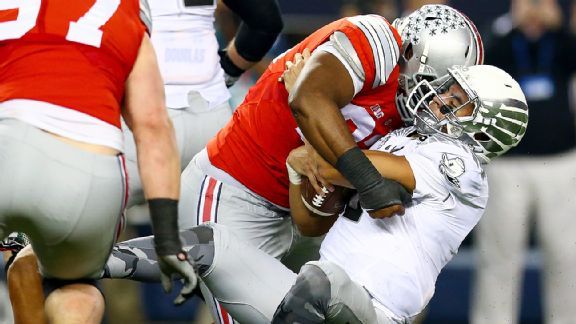 Ronald Martinez/Getty Images
Ronald Martinez/Getty ImagesOhio State’s defense Monday night performed better than traditional stats say.In Monday night’s College Football Playoff National Championship Presented by AT&T, Oregon gained 465 yards against Ohio State. That’s about 56 yards more than the FBS average in a game in 2014, and it dropped Ohio State’s FBS rank in total defense from 17th to 19th. So by yardage numbers traditionally used to rate and rank defenses, Monday night’s performance was below average.
But defense is about more than yards allowed. Looking at it on a drive-by-drive basis, Ohio State held Oregon without points on 10 of its 14 drives -- six punts, two turnovers on downs, the end of the first half and the game-ending interception. Preventing the Ducks from scoring on fourth-and-goal early in the second quarter and holding them to field goal attempts on two other red zone drives were particularly strong defensive sequences the yardage numbers don’t capture well.
So even before adjusting for how strong Oregon’s offense is, Ohio State’s defense added more than four points to the scoring margin in terms of expected points added (EPA), taking into account all it did based on the situation before and after every play. That’s not a tremendous number, but given that the FBS average is about zero, it does show that the defense was a positive for the Buckeyes within the game.
To get a more accurate measure of Ohio State’s defense compared with other teams across all games, the performance should be adjusted for the fact it came against Oregon’s offense, which ranks best in FBS in terms of offensive efficiency (based on EPA per game, adjusted for opponent strength). With that adjustment, Ohio State’s defense comes out as plus-23.8 in the national title game -- an extremely positive performance. In fact, it was the third-best defensive performance of the 2014 bowl season and the 11th-best in any BCS/New Year’s Six bowl game going back 10 seasons.
In summary, if you use yards, Ohio State’s defense played worse than average Monday night. If you use expected points added, it looks better than average. And if you adjust that for the quality of Oregon’s offense, it looks way better than average -- which is more in line with reality.
Ohio State’s defense in College Football Playoff championship game against Oregon
Most champions rank better in efficiency than yards or points per game
National champion Ohio State finished the season fourth in offensive efficiency and 16th in defensive efficiency. Efficiency measures the contribution of the given unit to the scoring margin across all plays, adjusted for opponent strength.
The Buckeyes, like each of the eight national champions before them, ranked better in offensive efficiency than in yards per game and points per game at the end of the season. Specific to yards per game -- the default measure of offense -- the national champion ranked better in efficiency each time, by an average of 13 to 14 spots.
Offensive ranks of national champions past 10 seasons
The story is similar but not as extreme with defense. Each of the past five and eight of the past 10 national champions rank at least as highly in defensive efficiency as yards or points allowed.
Defensive ranks of national champions past 10 seasons
Looking across both offensive and defensive efficiency, each of the last 10 national champions has ranked in the top five of at least one of these categories at the end of the season, with nine of the 10 ranking in the top 16 of both categories. This cannot be said about the yardage or points-based measures of offense and defense.
A set of 10 good teams ranking better in efficiency than the traditional stats is by no means proof that the efficiency stats are better -- they are better because of all they take into account that the traditional stats miss or wrongly assign. But it’s also good to know that the efficiency numbers align more with reality than the traditional stats do for the offenses and defenses of the college football teams that finished at the top the past 10 years.
